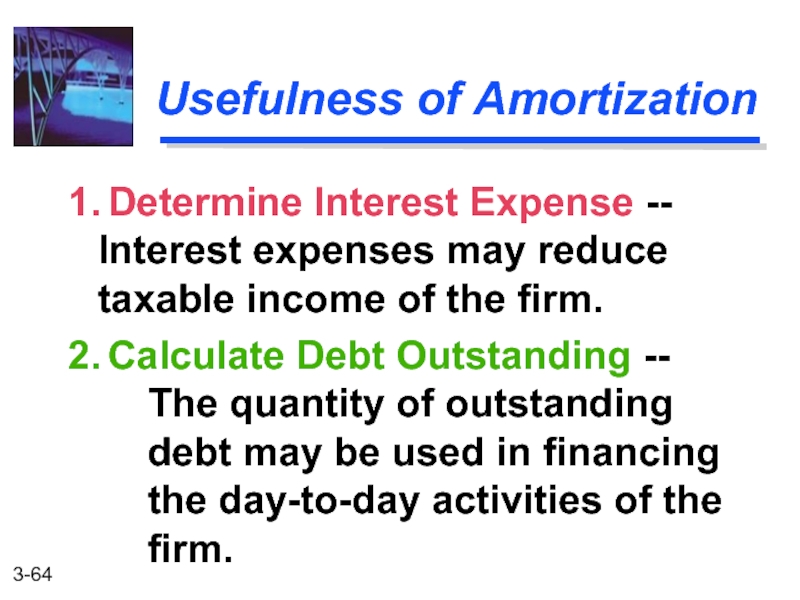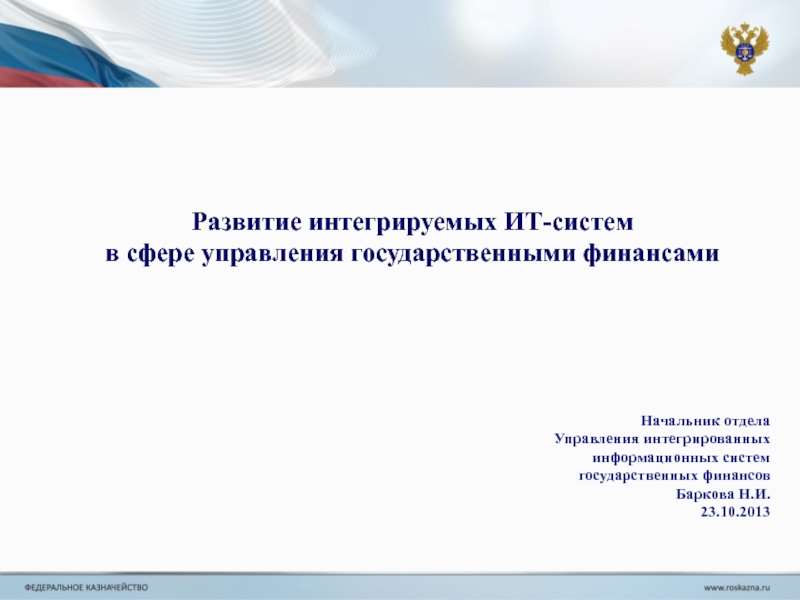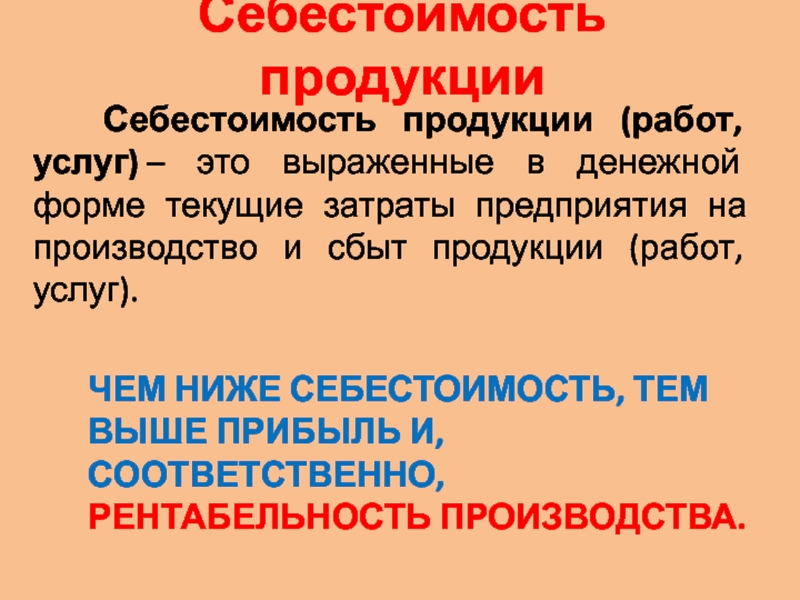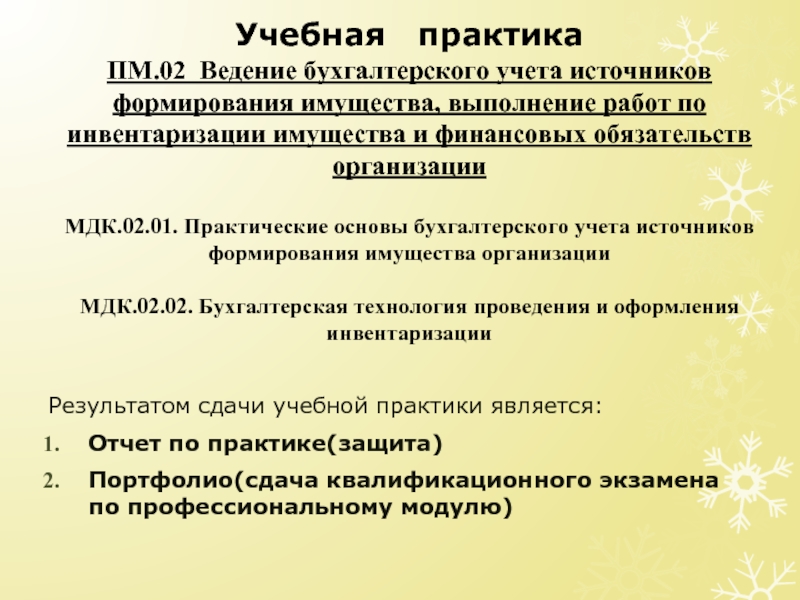- Главная
- Разное
- Дизайн
- Бизнес и предпринимательство
- Аналитика
- Образование
- Развлечения
- Красота и здоровье
- Финансы
- Государство
- Путешествия
- Спорт
- Недвижимость
- Армия
- Графика
- Культурология
- Еда и кулинария
- Лингвистика
- Английский язык
- Астрономия
- Алгебра
- Биология
- География
- Детские презентации
- Информатика
- История
- Литература
- Маркетинг
- Математика
- Медицина
- Менеджмент
- Музыка
- МХК
- Немецкий язык
- ОБЖ
- Обществознание
- Окружающий мир
- Педагогика
- Русский язык
- Технология
- Физика
- Философия
- Химия
- Шаблоны, картинки для презентаций
- Экология
- Экономика
- Юриспруденция
Time Value of Money презентация
Содержание
- 1. Time Value of Money
- 2. After studying Chapter 3, you should be
- 3. The Time Value of Money The
- 4. Obviously, $10,000 today. You already recognize
- 5. TIME allows you the opportunity to
- 6. Types of Interest Compound Interest Interest paid
- 7. Simple Interest Formula Formula SI = P0(i)(n)
- 8. SI = P0(i)(n) = $1,000(.07)(2) = $140 Simple Interest
- 9. FV = P0 + SI = $1,000
- 10. The Present Value is simply the $1,000
- 11. Why Compound Interest? Future Value (U.S. Dollars)
- 12. Assume that you deposit $1,000 at a
- 13. FV1 = P0 (1+i)1 = $1,000 (1.07) =
- 14. FV1 = P0 (1+i)1 = $1,000 (1.07)
- 15. FV1 = P0(1+i)1 FV2 = P0(1+i)2
- 16. FVIFi,n is found on Table I
- 17. FV2 = $1,000 (FVIF7%,2) = $1,000 (1.145) = $1,145 [Due to Rounding] Using Future Value Tables
- 18. Using MS Excel =FV(rate, nper, pmt,pv)
- 19. Julie Miller wants to know how large
- 20. Calculation based on Table I: FV5 = $10,000
- 21. Using Excel =FV(0.1,5,,-10000) = $16,105.10 Interest
- 22. We will use the “Rule-of-72”. Double
- 23. Approx. Years to Double = 72
- 24. Using Excel =nper(rate, pmt,pv, fv) =nper(.12,, -5000,10000) =6.11 years .
- 25. Assume that you need $1,000 in 2
- 26. PV0 = FV2 / (1+i)2
- 27. PV0 = FV1 / (1+i)1 PV0
- 28. PVIFi,n is found on Table II
- 29. PV2 = $1,000 (PVIF7%,2) = $1,000 (.873) = $873 [Due to Rounding] Using Present Value Tables
- 30. Julie Miller wants to know how large
- 31. Calculation based on general formula: PV0 =
- 32. Types of Annuities Ordinary Annuity: Payments or
- 33. Examples of Annuities Student Loan Payments
- 34. Parts of an Annuity 0
- 35. Parts of an Annuity 0
- 36. FVAn = R(1+i)n-1 + R(1+i)n-2 +
- 37. FVA3 = $1,000(1.07)2 +
- 38. Hint on Annuity Valuation The future value
- 39. FVAn = R (FVIFAi%,n) FVA3 = $1,000
- 40. FVADn = R(1+i)n + R(1+i)n-1 +
- 41. FVAD3 = $1,000(1.07)3 +
- 42. PVAn = R/(1+i)1 + R/(1+i)2
- 43. PVA3 = $1,000/(1.07)1 +
- 44. Hint on Annuity Valuation The present value
- 45. PVAn = R (PVIFAi%,n) PVA3 = $1,000
- 46. PVADn = R/(1+i)0 + R/(1+i)1 +
- 47. PVADn = $1,000/(1.07)0 + $1,000/(1.07)1 +
- 48. PVADn = R (PVIFAi%,n)(1+i) PVAD3 = $1,000
- 49. Solving the PVAD Problem
- 50. 1. Read problem thoroughly 2. Create a
- 51. Julie Miller will receive the set of
- 52. 1. Solve a “piece-at-a-time” by discounting each piece
- 53. “Piece-At-A-Time” 0
- 54. “Group-At-A-Time” (#1) 0
- 55. “Group-At-A-Time” (#2) 0
- 56. General Formula: FVn = PV0(1 + [i/m])mn n:
- 57. Julie Miller has $1,000 to invest for
- 58. Qrtly FV2 = 1,000(1+ [.12/4])(4)(2)
- 59. Effective Annual Interest Rate The actual
- 60. Basket Wonders (BW) has a $1,000 CD
- 61. 1. Calculate the payment per period. 2. Determine the
- 62. Julie Miller is borrowing $10,000 at a
- 63. Amortizing a Loan Example [Last Payment Slightly Higher Due to Rounding]
- 64. Usefulness of Amortization 2. Calculate Debt Outstanding --
Слайд 2After studying Chapter 3, you should be able to:
Understand what is
Understand the relationship between present and future value.
Describe how the interest rate can be used to adjust the value of cash flows – both forward and backward – to a single point in time.
Calculate both the future and present value of: (a) an amount invested today; (b) a stream of equal cash flows (an annuity); and (c) a stream of mixed cash flows.
Distinguish between an “ordinary annuity” and an “annuity due.”
Use interest factor tables and understand how they provide a shortcut to calculating present and future values.
Use interest factor tables to find an unknown interest rate or growth rate when the number of time periods and future and present values are known.
Build an “amortization schedule” for an installment-style loan.
Слайд 3The Time Value of Money
The Interest Rate
Simple Interest
Compound
Amortizing a Loan
Compounding More Than Once per Year
Слайд 4
Obviously, $10,000 today.
You already recognize that there is
TIME VALUE TO
The Interest Rate
Which would you prefer -- $10,000 today or $10,000 in 5 years?
Слайд 5
TIME allows you the opportunity to postpone consumption and earn INTEREST.
Why
Why is TIME such an important element in your decision?
Слайд 6Types of Interest
Compound Interest
Interest paid (earned) on any previous interest earned,
Simple Interest
Interest paid (earned) on only the original amount, or principal, borrowed (lent).
Слайд 7
Simple Interest Formula
Formula SI = P0(i)(n)
SI: Simple Interest
P0: Deposit today (t=0)
i: Interest Rate per Period
n: Number
Слайд 8SI = P0(i)(n) = $1,000(.07)(2) = $140
Simple Interest Example
Assume that you deposit $1,000
Слайд 9 FV = P0 + SI = $1,000 + $140 = $1,140
Future Value
Simple Interest (FV)
What is the Future Value (FV) of the deposit?
Слайд 10 The Present Value is simply the $1,000 you originally deposited. That
Present Value is the current value of a future amount of money, or a series of payments, evaluated at a given interest rate.
Simple Interest (PV)
What is the Present Value (PV) of the previous problem?
Слайд 12 Assume that you deposit $1,000 at a compound interest rate of
Future Value
Single Deposit (Graphic)
0 1 2
$1,000
FV2
7%
Слайд 13FV1 = P0 (1+i)1 = $1,000 (1.07) = $1,070
Compound Interest
You earned $70
This is the same amount of interest you would earn under simple interest.
Future Value
Single Deposit (Formula)
Слайд 14FV1 = P0 (1+i)1 = $1,000 (1.07) = $1,070
FV2 = FV1
You earned an EXTRA $4.90 in Year 2 with compound over simple interest.
Future Value
Single Deposit (Formula)
Слайд 15 FV1 = P0(1+i)1
FV2 = P0(1+i)2
General Future Value Formula:
FVn = P0
or FVn = P0 (FVIFi,n) -- See Table I
General Future Value Formula
etc.
Слайд 17 FV2 = $1,000 (FVIF7%,2) = $1,000 (1.145) = $1,145 [Due to Rounding]
Using Future
Слайд 18Using MS Excel
=FV(rate, nper, pmt,pv)
=FV is a function used for
Rate= the interest rate
Nper = number of periods
Pv=the present value
Слайд 19 Julie Miller wants to know how large her deposit of $10,000
Story Problem Example
0 1 2 3 4 5
$10,000
FV5
10%
Слайд 20Calculation based on Table I: FV5 = $10,000 (FVIF10%, 5) = $10,000 (1.611) =
Story Problem Solution
Calculation based on general formula: FVn = P0 (1+i)n FV5 = $10,000 (1+ 0.10)5 = $16,105.10
Слайд 21Using Excel
=FV(0.1,5,,-10000) = $16,105.10
Interest = 10% or 0.1
Nper = 5
PV
Слайд 22
We will use the “Rule-of-72”.
Double Your Money!!!
Quick! How long does it
Слайд 23
Approx. Years to Double = 72 / i%
72 / 12%
[Actual Time is 6.12 Years]
The “Rule-of-72”
Quick! How long does it take to double $5,000 at a compound rate of 12% per year (approx.)?
Слайд 25Assume that you need $1,000 in 2 years. Let’s examine the
0 1 2
$1,000
7%
PV1
PV0
Present Value Single Deposit (Graphic)
Слайд 26 PV0 = FV2 / (1+i)2 = $1,000 / (1.07)2
Present Value
Single Deposit (Formula)
0 1 2
$1,000
7%
PV0
Слайд 27 PV0 = FV1 / (1+i)1
PV0 = FV2 / (1+i)2
General Present
PV0 = FVn / (1+i)n
or PV0 = FVn (PVIFi,n) -- See Table II
General Present Value Formula
etc.
Слайд 30 Julie Miller wants to know how large of a deposit to
Story Problem Example
0 1 2 3 4 5
$10,000
PV0
10%
Слайд 31 Calculation based on general formula: PV0 = FVn / (1+i)n PV0
Calculation based on Table I: PV0 = $10,000 (PVIF10%, 5) = $10,000 (.621) = $6,210.00 [Due to Rounding]
Story Problem Solution
Слайд 32Types of Annuities
Ordinary Annuity: Payments or receipts occur at the end
Annuity Due: Payments or receipts occur at the beginning of each period.
An Annuity represents a series of equal payments (or receipts) occurring over a specified number of equidistant periods.
Слайд 33Examples of Annuities
Student Loan Payments
Car Loan Payments
Insurance Premiums
Retirement Savings
Слайд 34Parts of an Annuity
0
$100 $100 $100
(Ordinary Annuity)
End of
Period 1
End of
Period 2
Today
Equal Cash Flows
Each 1 Period Apart
End of
Period 3
Слайд 35Parts of an Annuity
0
$100 $100 $100
(Annuity Due)
Beginning of
Period 1
Beginning of
Period 2
Today
Equal Cash Flows
Each 1 Period Apart
Beginning of
Period 3
Слайд 36
FVAn = R(1+i)n-1 + R(1+i)n-2 + ... +
Overview of an
Ordinary Annuity -- FVA
R R R
0 1 2 n n+1
FVAn
R = Periodic
Cash Flow
Cash flows occur at the end of the period
i%
. . .
Слайд 37
FVA3 = $1,000(1.07)2 + $1,000(1.07)1 + $1,000(1.07)0
Example of an
Ordinary Annuity -- FVA
$1,000 $1,000 $1,000
0 1 2 3 4
$3,215 = FVA3
7%
$1,070
$1,145
Cash flows occur at the end of the period
Слайд 38Hint on Annuity Valuation
The future value of an ordinary annuity can
Слайд 39 FVAn = R (FVIFAi%,n) FVA3 = $1,000 (FVIFA7%,3) = $1,000 (3.215) =
Valuation Using Table III
Слайд 40
FVADn = R(1+i)n + R(1+i)n-1 + ...
Overview View of an
Annuity Due -- FVAD
R R R R R
0 1 2 3 n-1 n
FVADn
i%
. . .
Cash flows occur at the beginning of the period
Слайд 41
FVAD3 = $1,000(1.07)3 + $1,000(1.07)2 + $1,000(1.07)1
Example of an
Annuity Due -- FVAD
$1,000 $1,000 $1,000 $1,070
0 1 2 3 4
$3,440 = FVAD3
7%
$1,225
$1,145
Cash flows occur at the beginning of the period
Слайд 42
PVAn = R/(1+i)1 + R/(1+i)2
+ ... + R/(1+i)n
Overview of
R R R
0 1 2 n n+1
PVAn
R = Periodic
Cash Flow
i%
. . .
Cash flows occur at the end of the period
Слайд 43
PVA3 = $1,000/(1.07)1 + $1,000/(1.07)2 + $1,000/(1.07)3
Example of an
Ordinary Annuity -- PVA
$1,000 $1,000 $1,000
0 1 2 3 4
$2,624.32 = PVA3
7%
$934.58
$873.44
$816.30
Cash flows occur at the end of the period
Слайд 44Hint on Annuity Valuation
The present value of an ordinary annuity can
Слайд 45 PVAn = R (PVIFAi%,n) PVA3 = $1,000 (PVIFA7%,3) = $1,000 (2.624) =
Valuation Using Table IV
Слайд 46
PVADn = R/(1+i)0 + R/(1+i)1 + ... + R/(1+i)n-1
Overview of an
Annuity Due -- PVAD
R R R R
0 1 2 n-1 n
PVADn
R: Periodic
Cash Flow
i%
. . .
Cash flows occur at the beginning of the period
Слайд 47
PVADn = $1,000/(1.07)0 + $1,000/(1.07)1 + $1,000/(1.07)2 = $2,808.02
Example of an
Annuity
$1,000.00 $1,000 $1,000
0 1 2 3 4
$2,808.02 = PVADn
7%
$ 934.58
$ 873.44
Cash flows occur at the beginning of the period
Слайд 48PVADn = R (PVIFAi%,n)(1+i)
PVAD3 = $1,000 (PVIFA7%,3)(1.07) = $1,000 (2.624)(1.07) =
Valuation Using Table IV
Слайд 49
Solving the PVAD Problem
N
I/Y
PV
PMT
FV
Inputs
Compute
3
2,808.02
Complete the problem the same as an “ordinary annuity” problem, except you must change the calculator setting to “BGN” first. Don’t forget to change back!
Step 1: Press 2nd BGN keys
Step 2: Press 2nd SET keys
Step 3: Press 2nd QUIT keys
Слайд 501. Read problem thoroughly
2. Create a time line
3. Put cash flows
4. Determine if it is a PV or FV problem
5. Determine if solution involves a single CF, annuity stream(s), or mixed flow
6. Solve the problem
7. Check with financial calculator (optional)
Steps to Solve Time Value of Money Problems
Слайд 51 Julie Miller will receive the set of cash flows below. What
Mixed Flows Example
0 1 2 3 4 5
$600 $600 $400 $400 $100
PV0
10%
Слайд 52 1. Solve a “piece-at-a-time” by discounting each piece back to t=0.
2. Solve a
How to Solve?
Слайд 53“Piece-At-A-Time”
0 1
$600 $600 $400 $400 $100
10%
$545.45
$495.87
$300.53
$273.21
$ 62.09
$1677.15 = PV0 of the Mixed Flow
Слайд 54“Group-At-A-Time” (#1)
0 1
$600 $600 $400 $400 $100
10%
$1,041.60
$ 573.57
$ 62.10
$1,677.27 = PV0 of Mixed Flow [Using Tables]
$600(PVIFA10%,2) = $600(1.736) = $1,041.60
$400(PVIFA10%,2)(PVIF10%,2) = $400(1.736)(0.826) = $573.57
$100 (PVIF10%,5) = $100 (0.621) = $62.10
Слайд 55“Group-At-A-Time” (#2)
0 1
$400 $400 $400 $400
PV0 equals
$1677.30.
0 1 2
$200 $200
0 1 2 3 4 5
$100
$1,268.00
$347.20
$62.10
Plus
Plus
Слайд 56General Formula:
FVn = PV0(1 + [i/m])mn
n: Number of Years m: Compounding
PV0: PV of the Cash Flow today
Frequency of Compounding
Слайд 57Julie Miller has $1,000 to invest for 2 Years at an
Annual FV2 = 1,000(1+ [.12/1])(1)(2) = 1,254.40
Semi FV2 = 1,000(1+ [.12/2])(2)(2) = 1,262.48
Impact of Frequency
Слайд 58Qrtly FV2 = 1,000(1+ [.12/4])(4)(2)
Monthly FV2 = 1,000(1+ [.12/12])(12)(2) = 1,269.73
Daily FV2 = 1,000(1+[.12/365])(365)(2) = 1,271.20
Impact of Frequency
Слайд 59
Effective Annual Interest Rate
The actual rate of interest earned (paid) after
(1 + [ i / m ] )m - 1
Effective Annual
Interest Rate
Слайд 60Basket Wonders (BW) has a $1,000 CD at the bank. The
EAR = ( 1 + 6% / 4 )4 - 1 = 1.0614 - 1 = .0614 or 6.14%!
BWs Effective
Annual Interest Rate
Слайд 611. Calculate the payment per period.
2. Determine the interest in Period t.
3. Compute principal payment in Period t. (Payment - Interest from Step 2)
4. Determine ending balance in Period t. (Balance - principal payment from Step 3)
5. Start again at Step 2 and repeat.
Steps to Amortizing a Loan
Слайд 62Julie Miller is borrowing $10,000 at a compound annual interest rate
Step 1: Payment
PV0 = R (PVIFA i%,n)
$10,000 = R (PVIFA 12%,5)
$10,000 = R (3.605)
R = $10,000 / 3.605 = $2,774
Amortizing a Loan Example
Слайд 64Usefulness of Amortization
2. Calculate Debt Outstanding -- The quantity of outstanding debt
1. Determine Interest Expense -- Interest expenses may reduce taxable income of the firm.
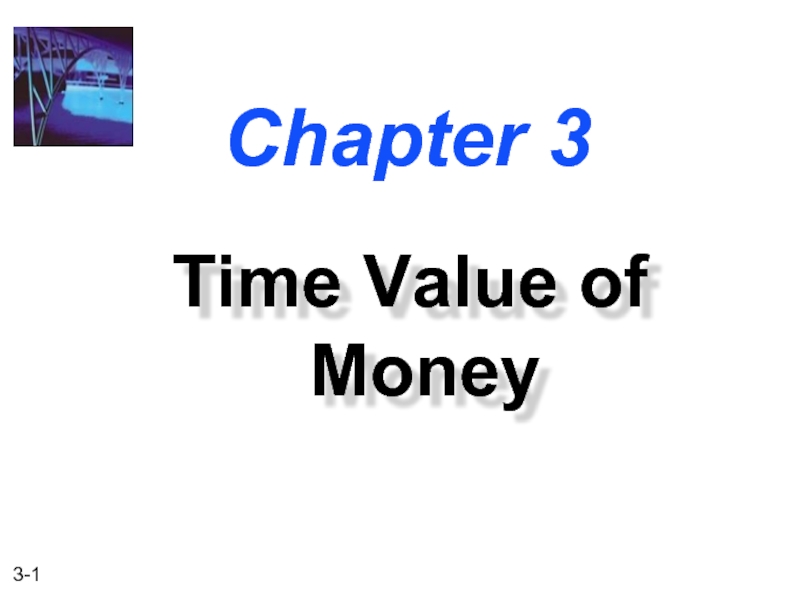
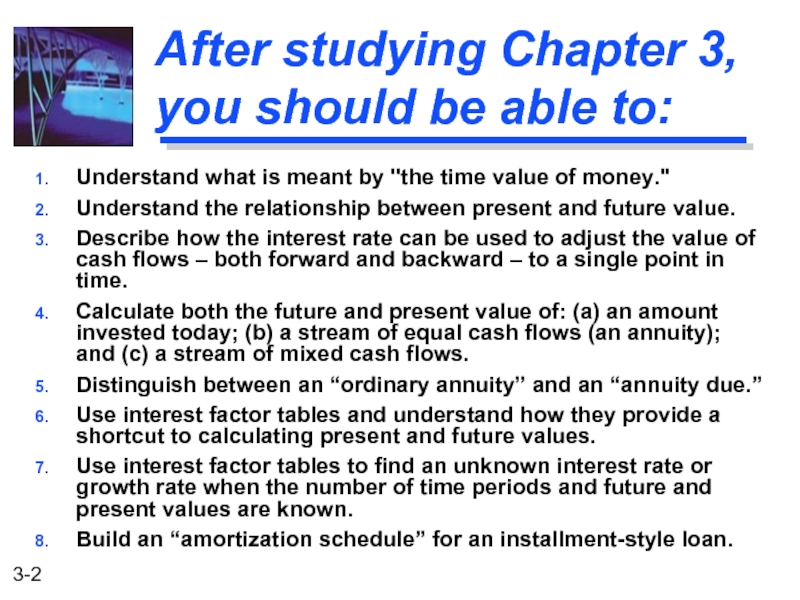
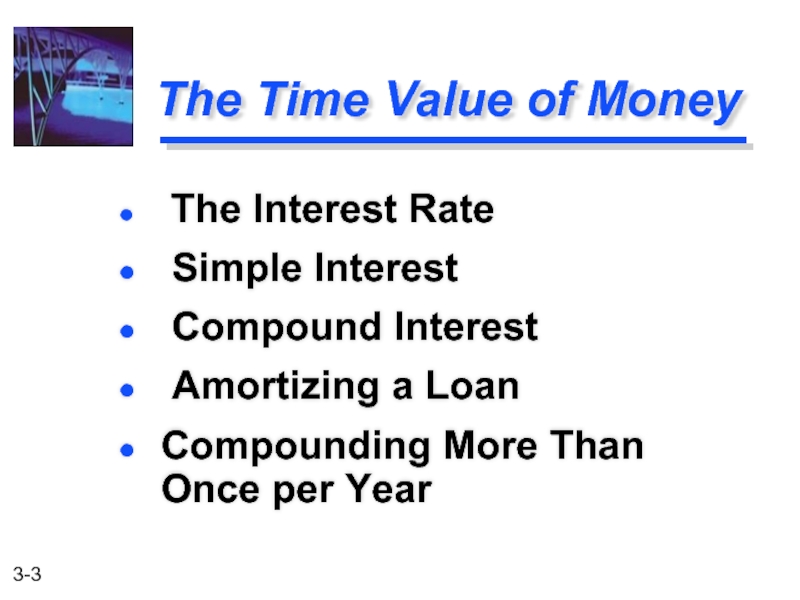
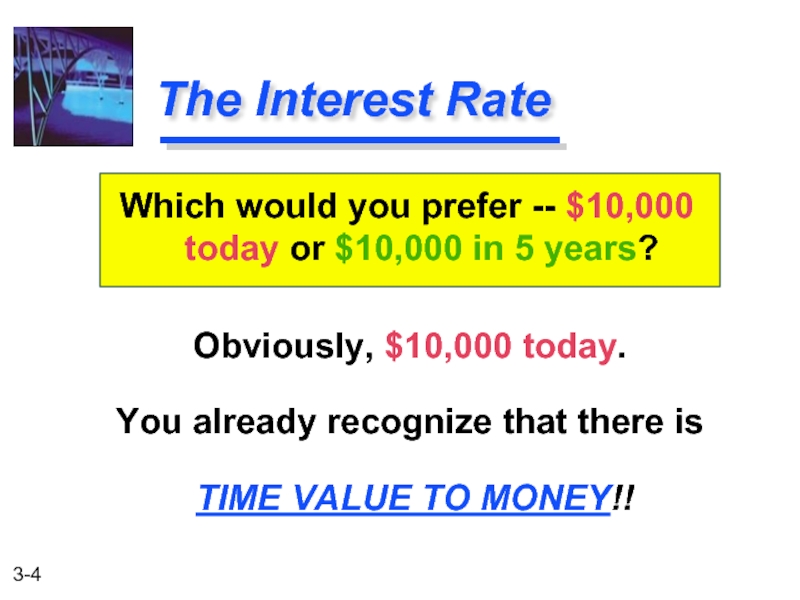
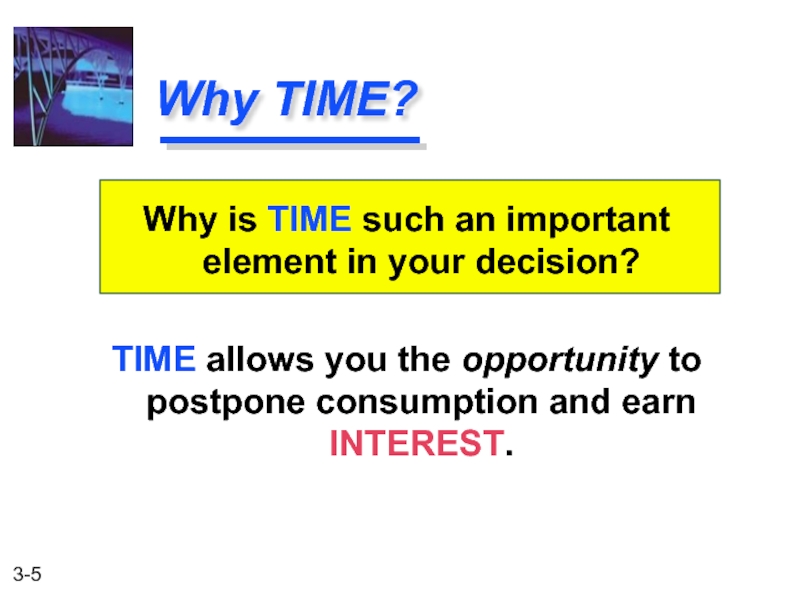
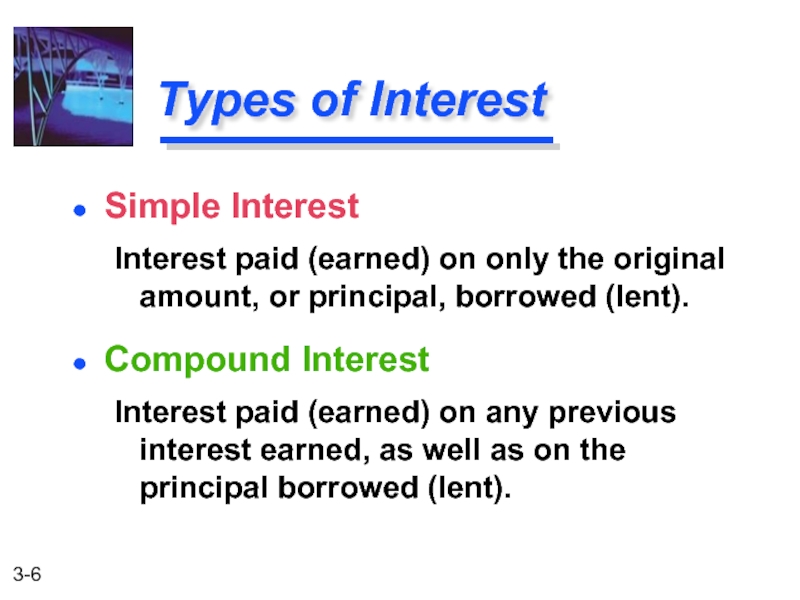
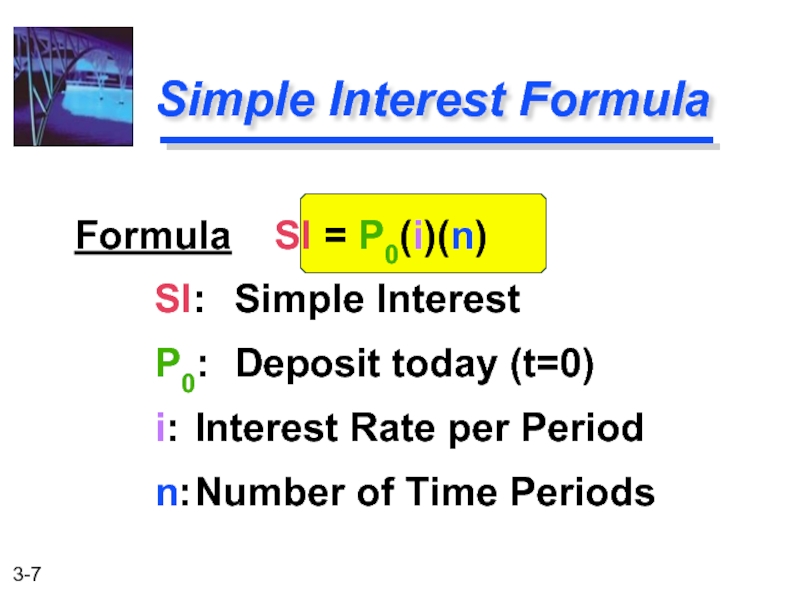
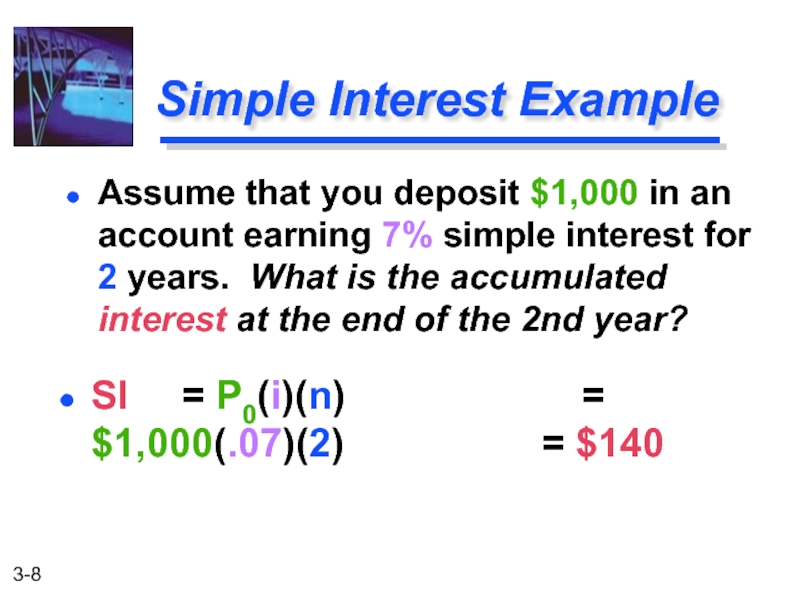
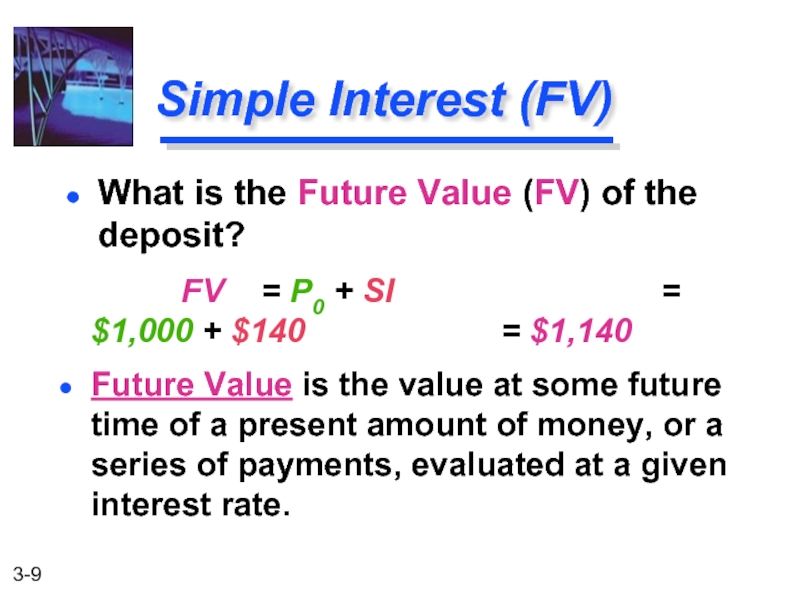
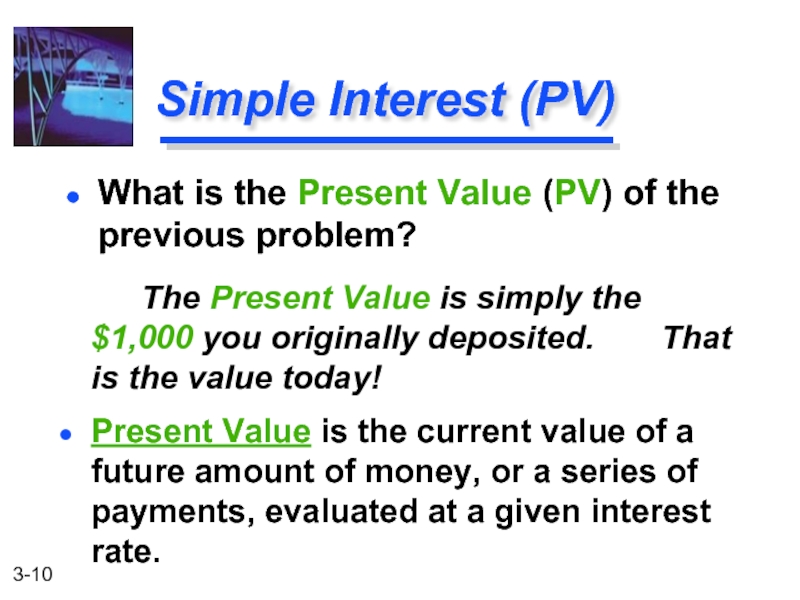
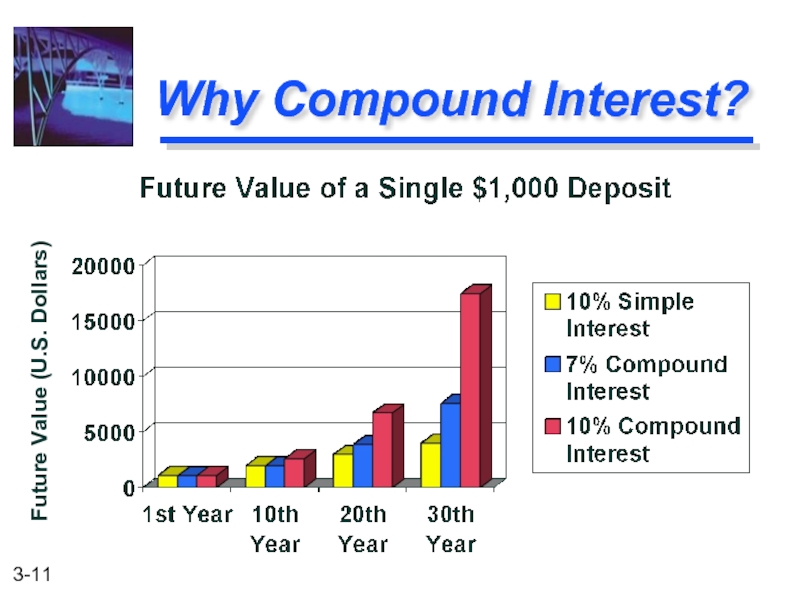
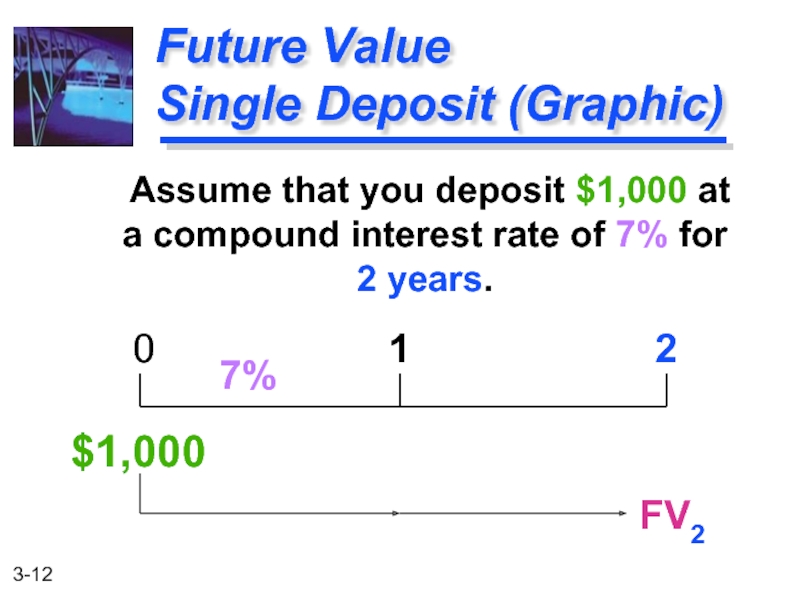
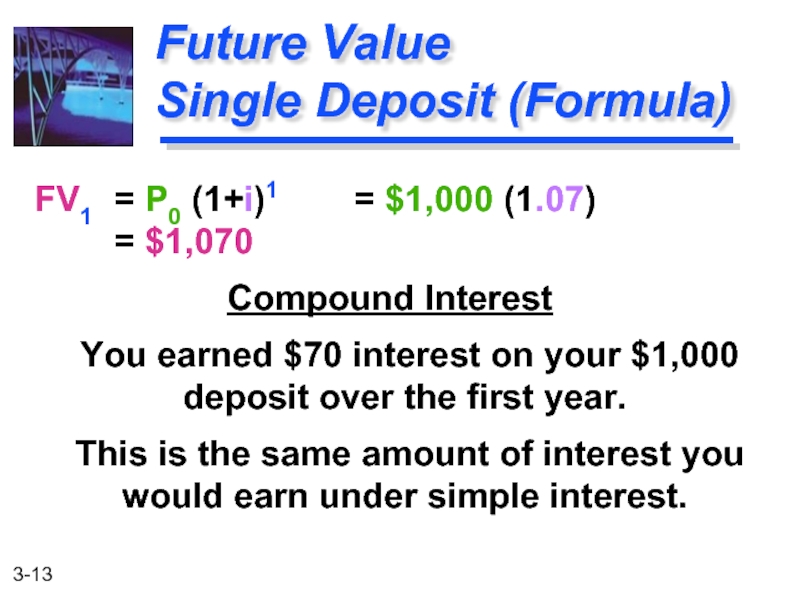
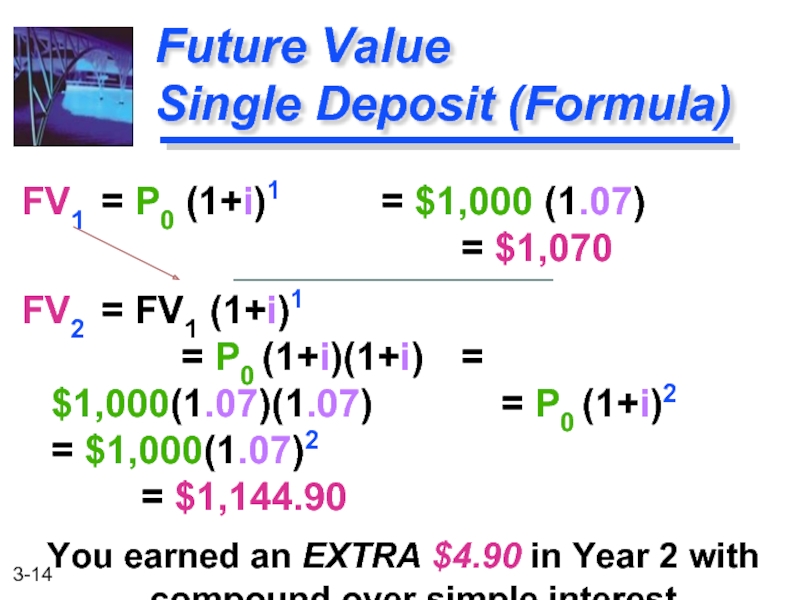
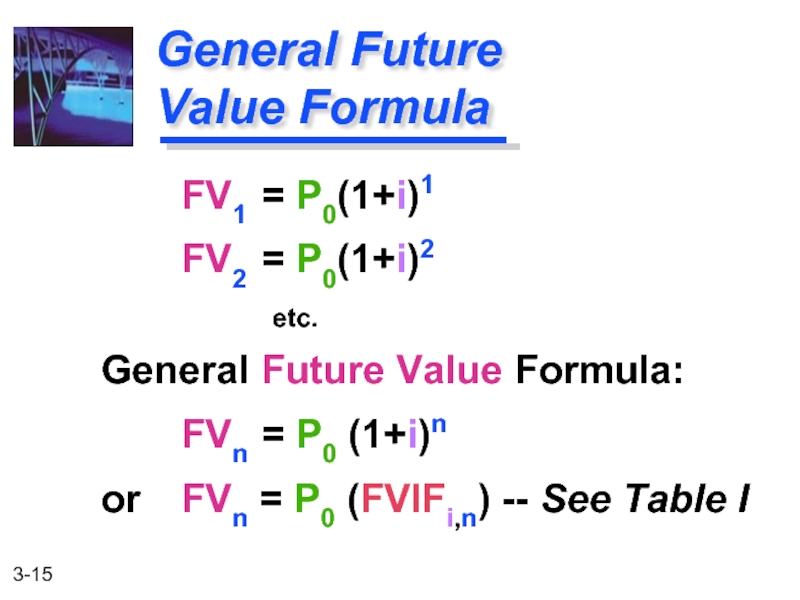
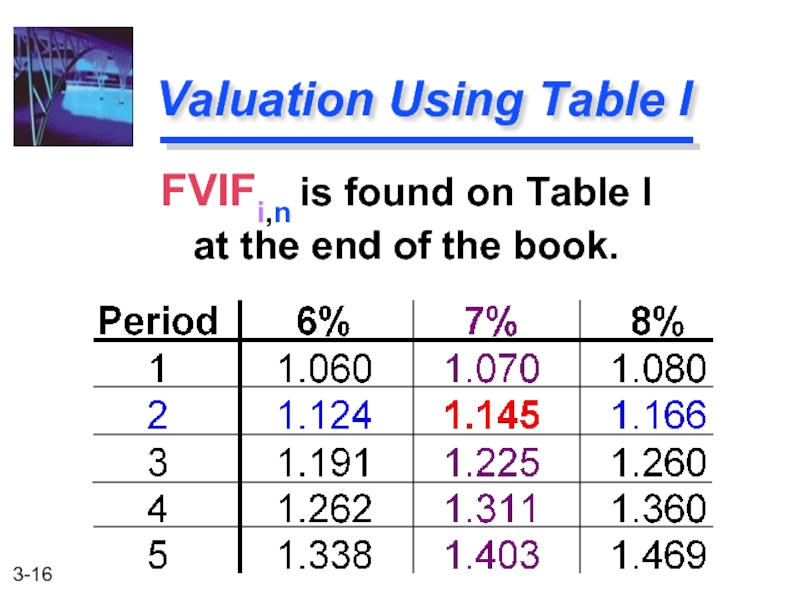
![FV2 = $1,000 (FVIF7%,2) = $1,000 (1.145) = $1,145 [Due to Rounding]Using Future Value Tables](/img/tmb/1/39864/f9e74004fc5896661fc9abf44a2c0807-800x.jpg)
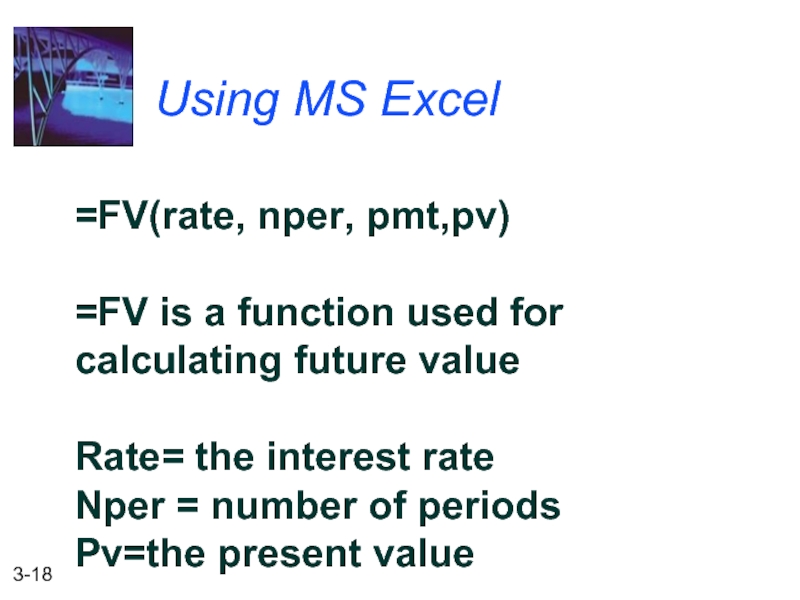
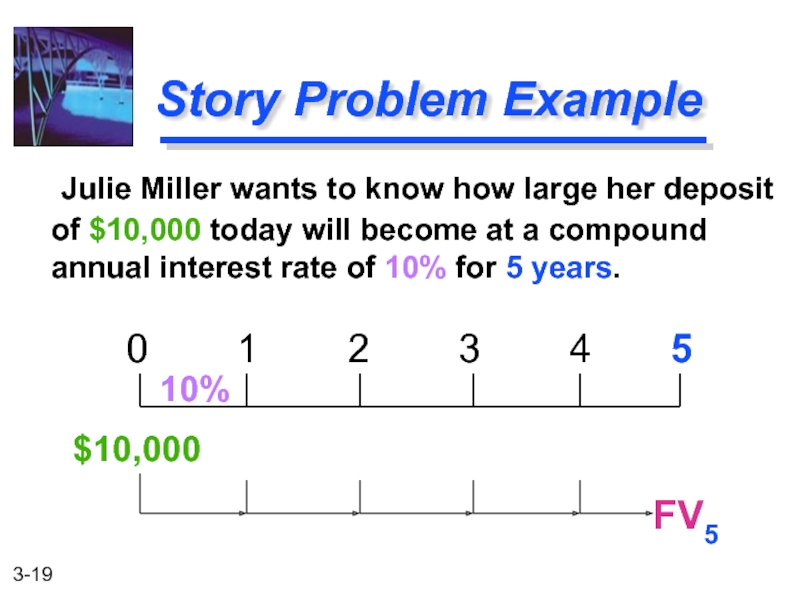
![Calculation based on Table I: FV5 = $10,000 (FVIF10%, 5) = $10,000 (1.611) = $16,110 [Due to Rounding]Story](/img/tmb/1/39864/41adc355f2aa497a5aa3b36b12ca23f9-800x.jpg)
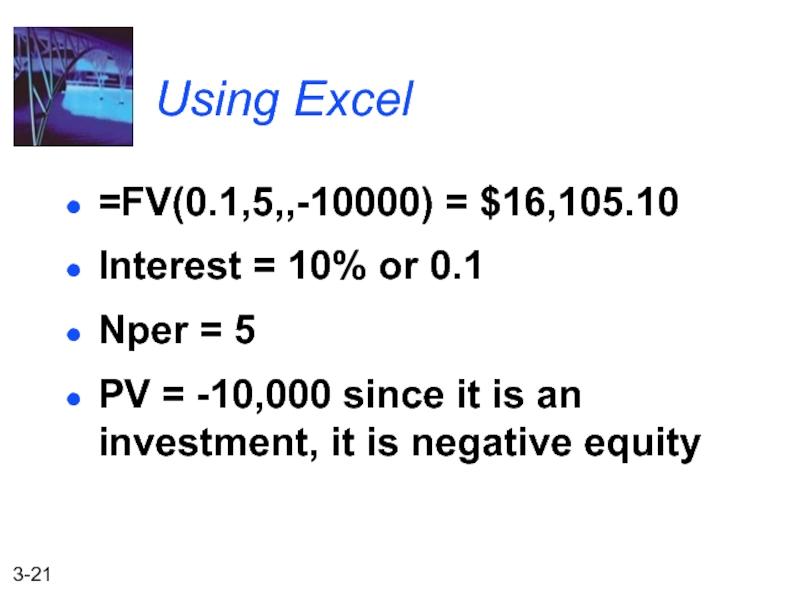
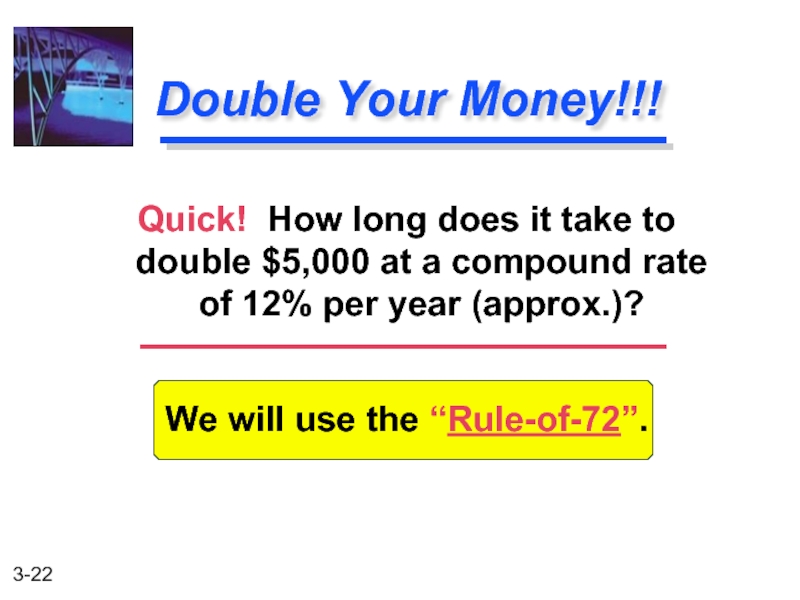
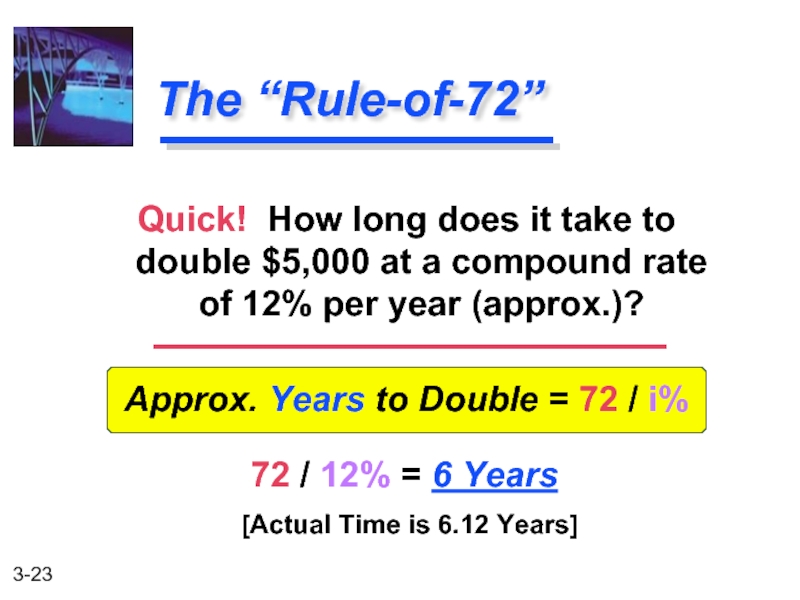

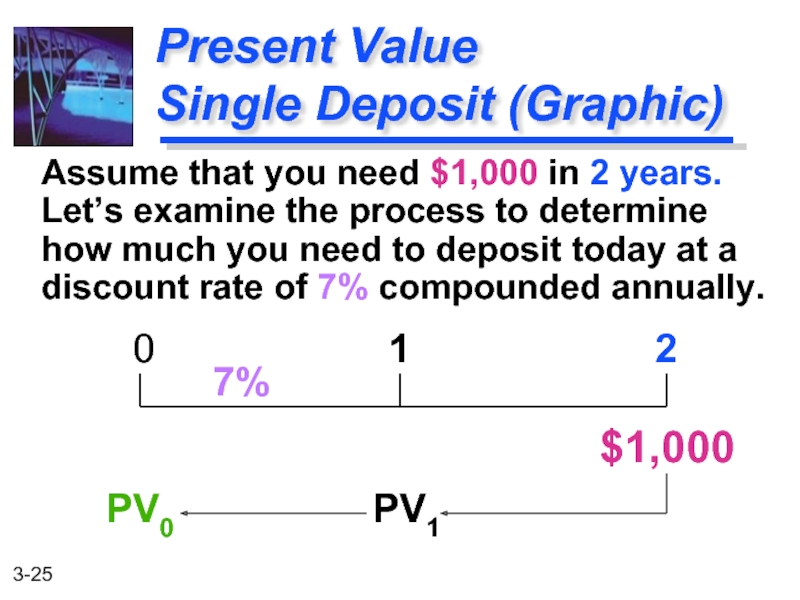
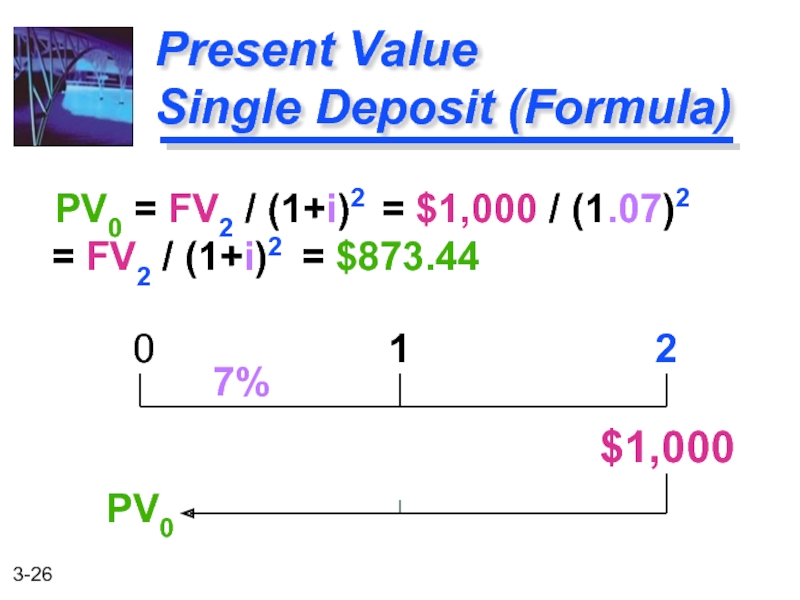
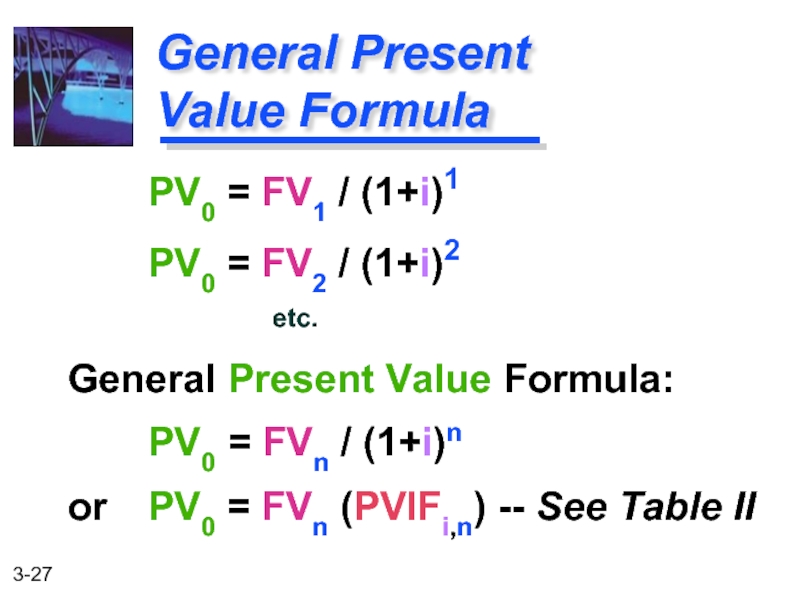
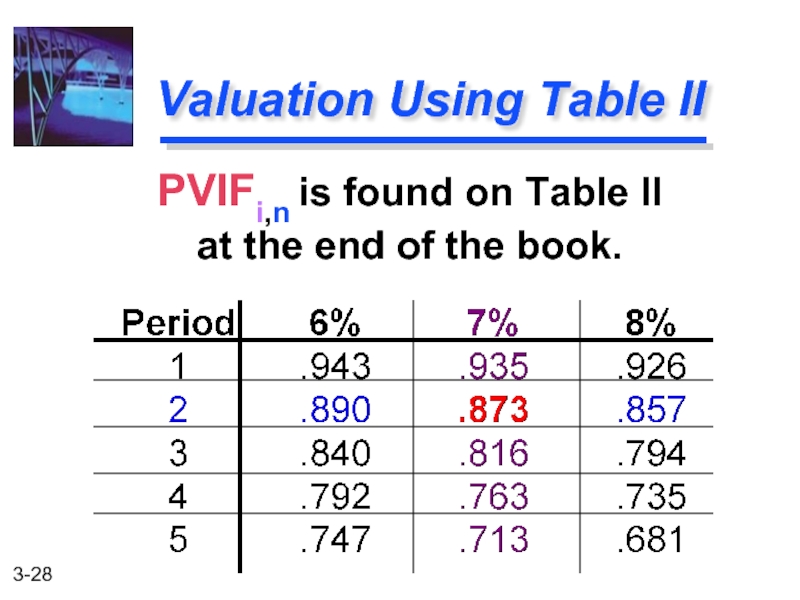
![PV2 = $1,000 (PVIF7%,2) = $1,000 (.873) = $873 [Due to Rounding]Using Present Value Tables](/img/tmb/1/39864/f03931645f9b86e3fa1fce624fe3ae13-800x.jpg)
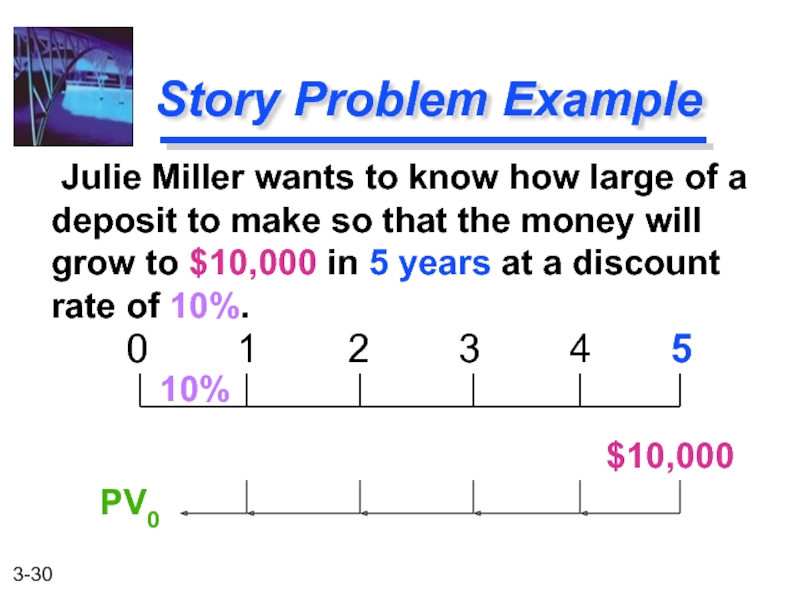
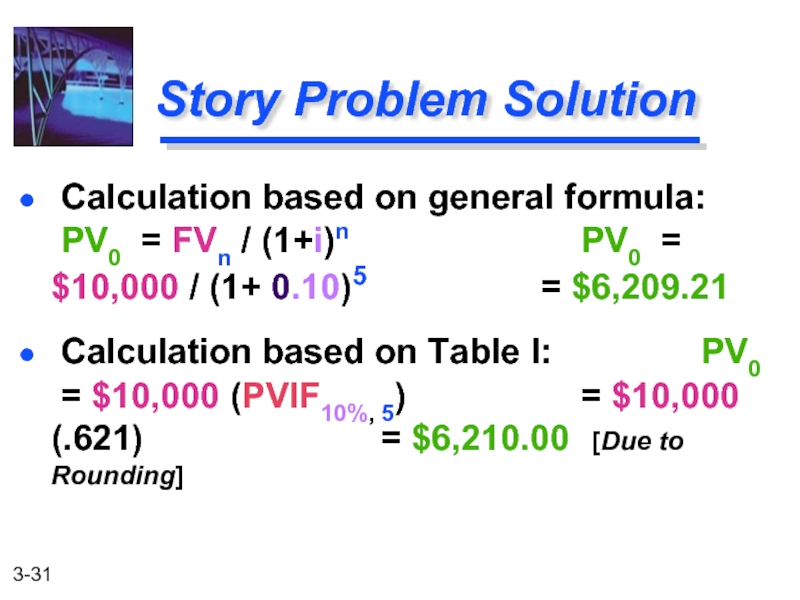
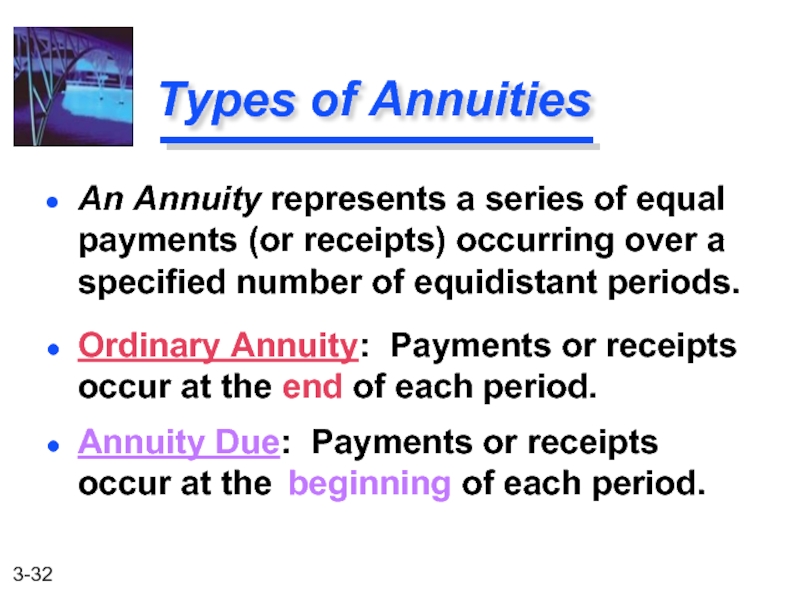
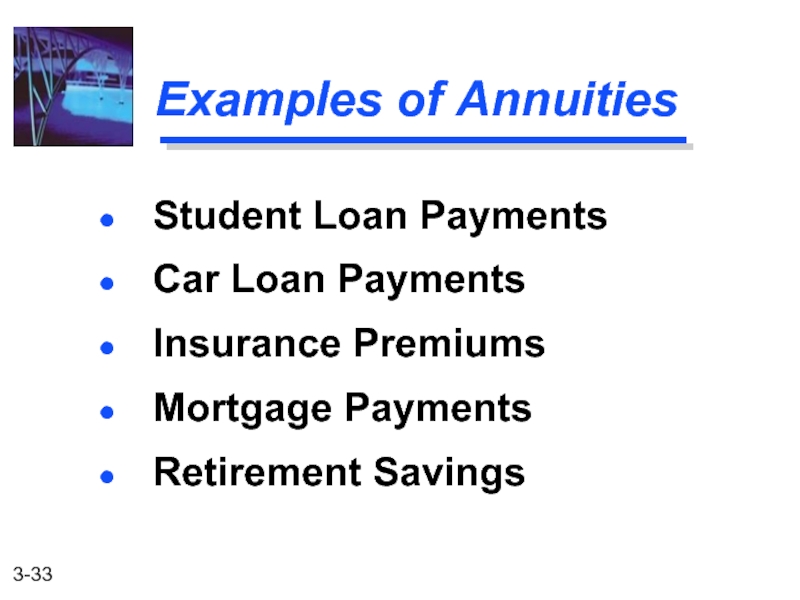
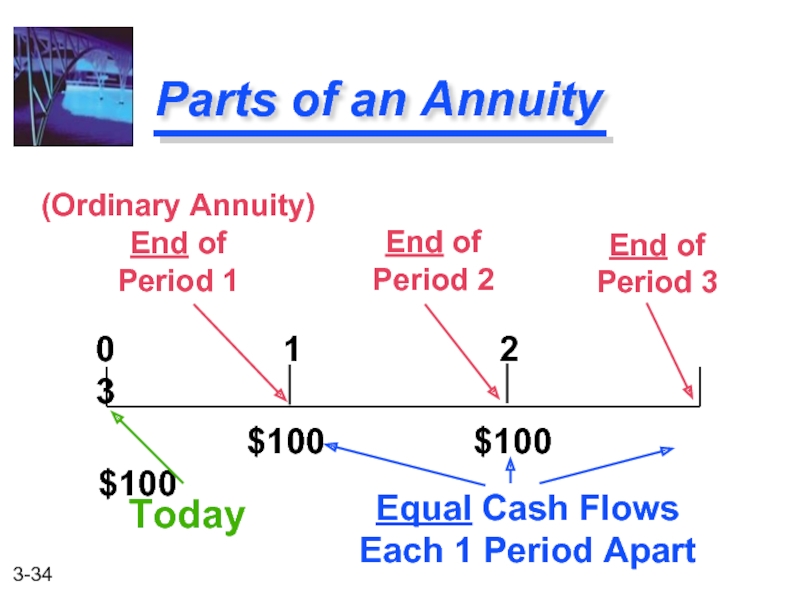
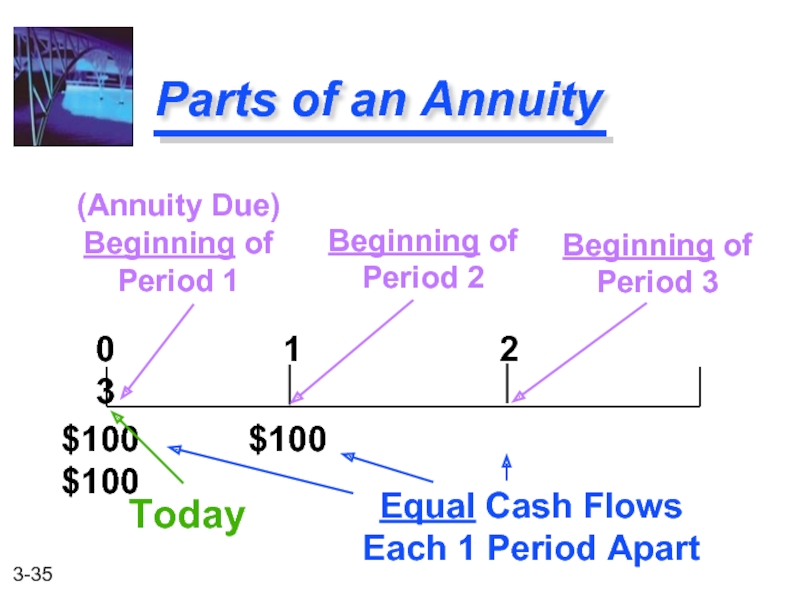
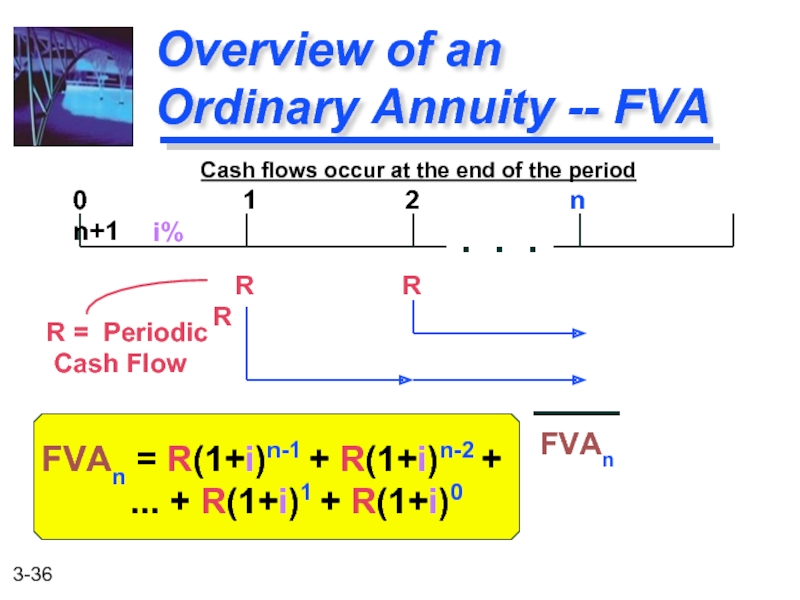
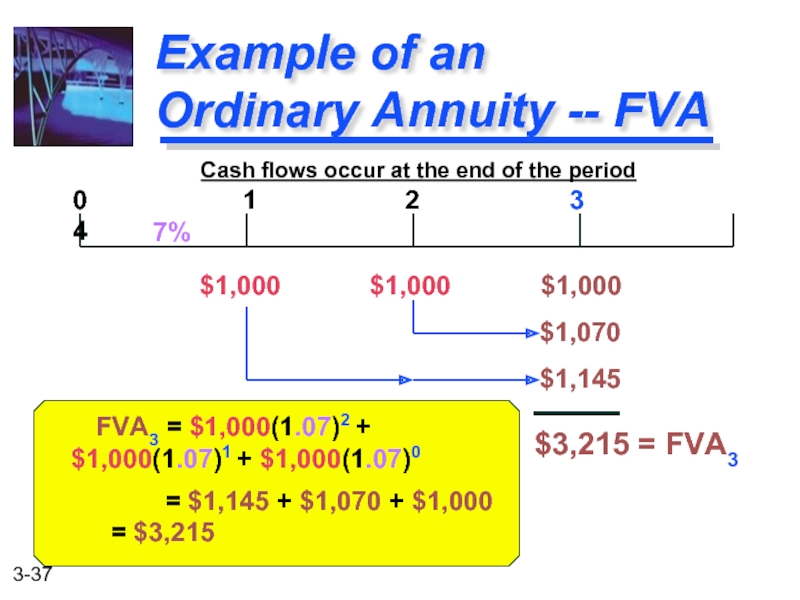
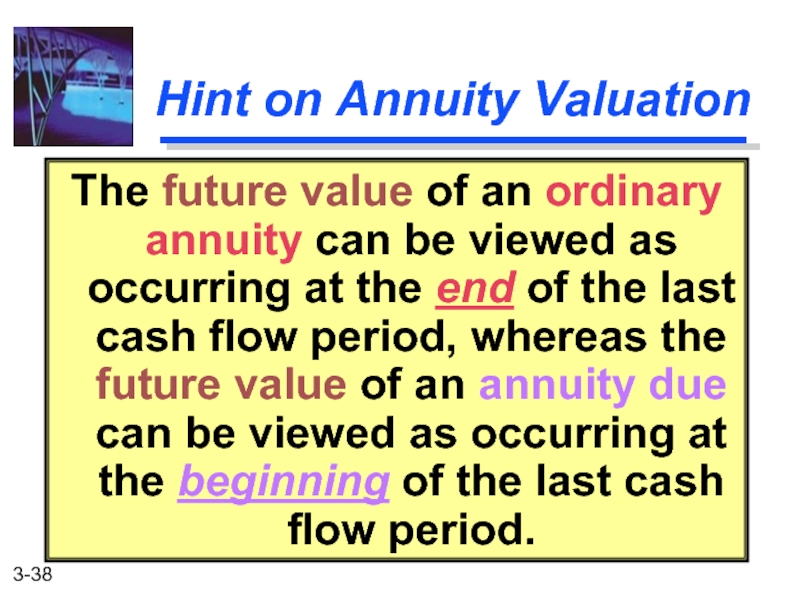
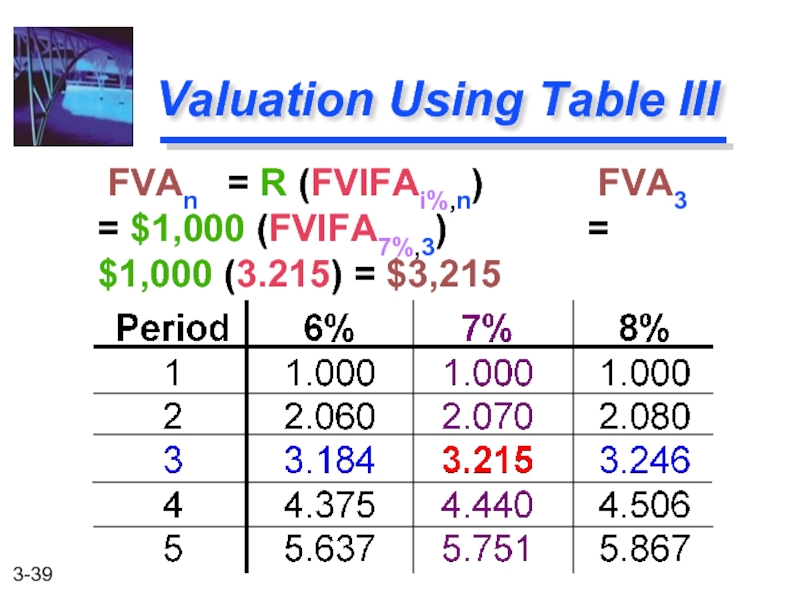
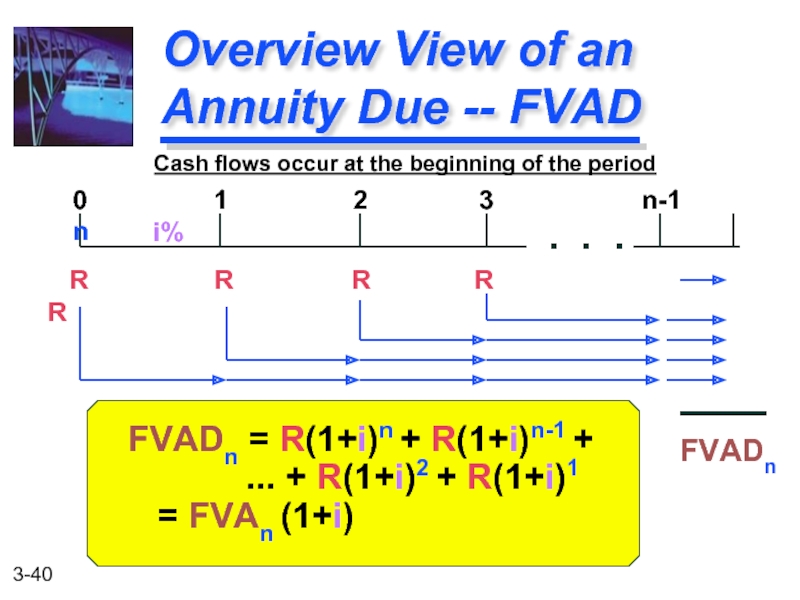
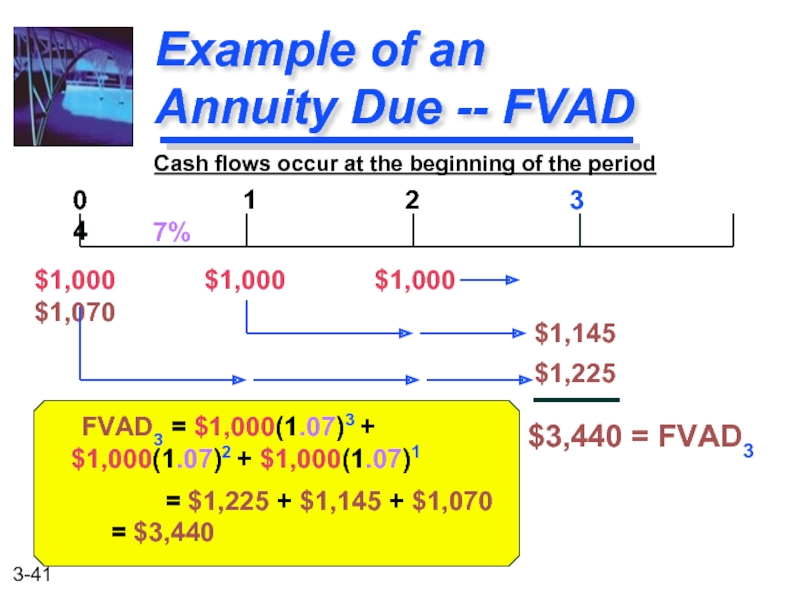
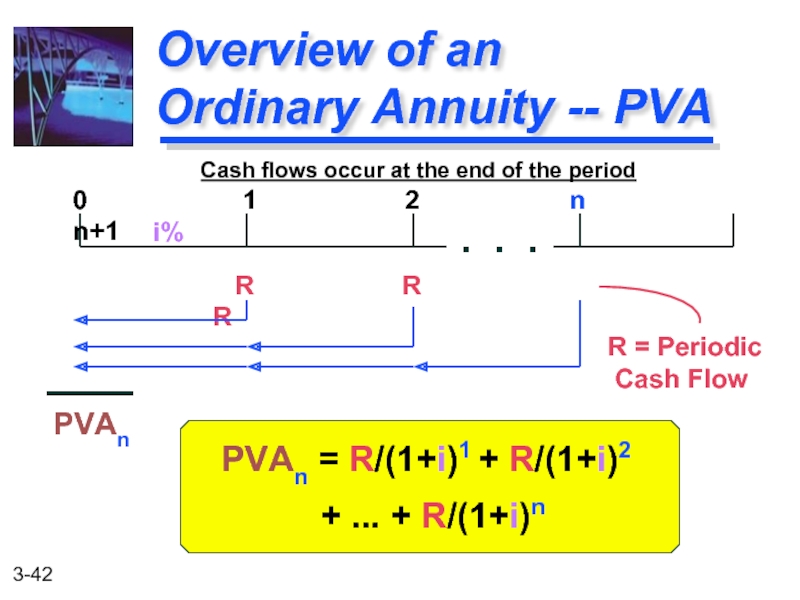
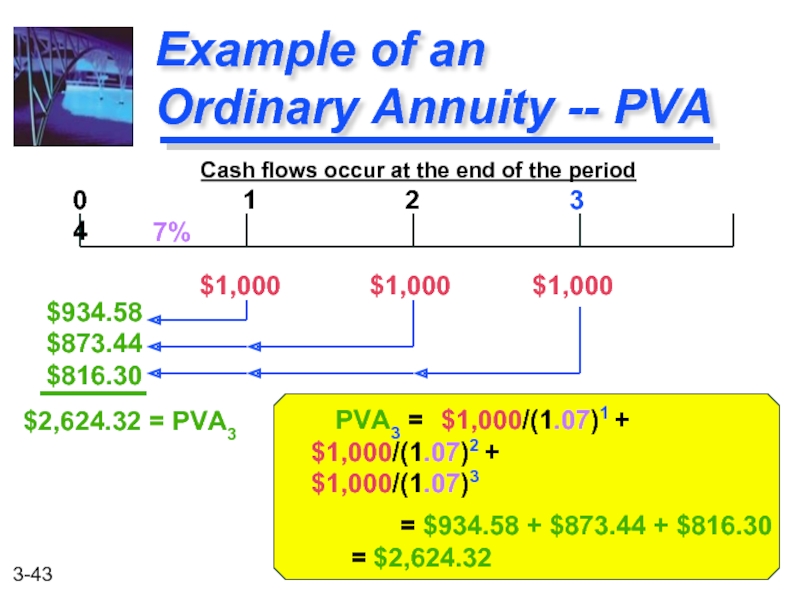
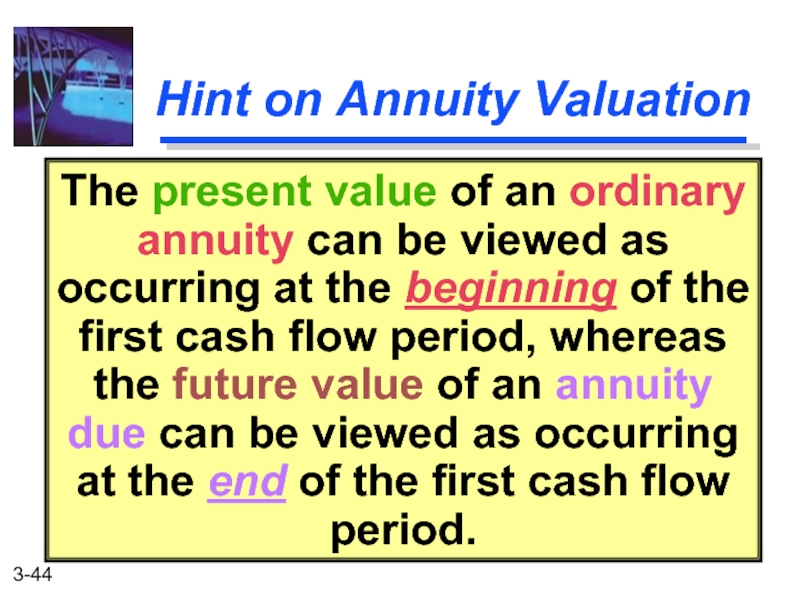
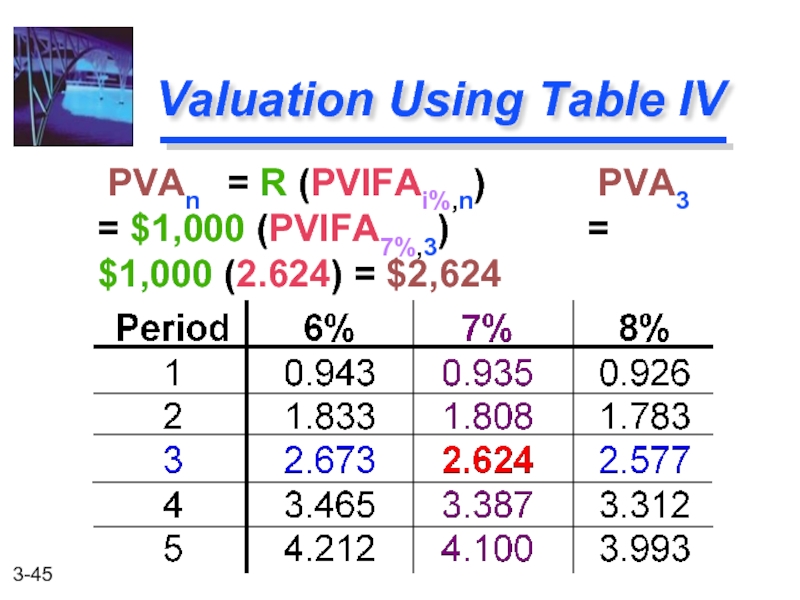
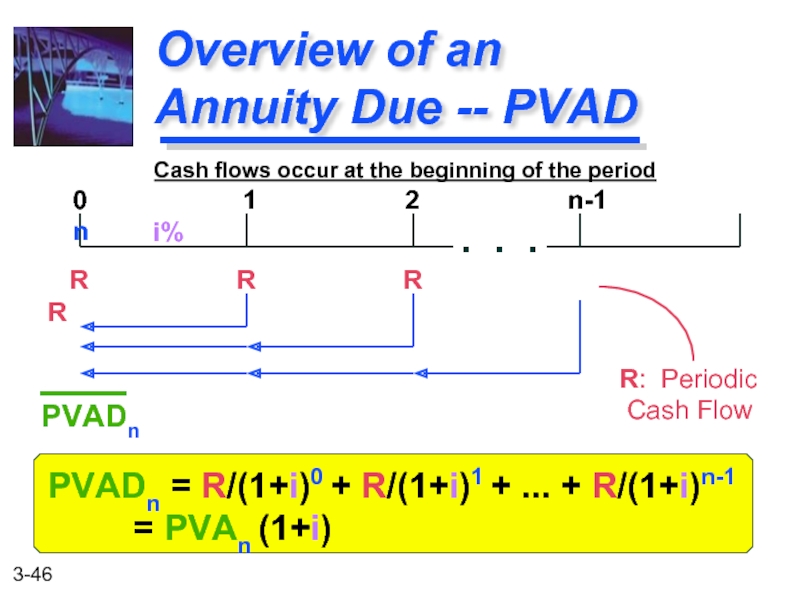
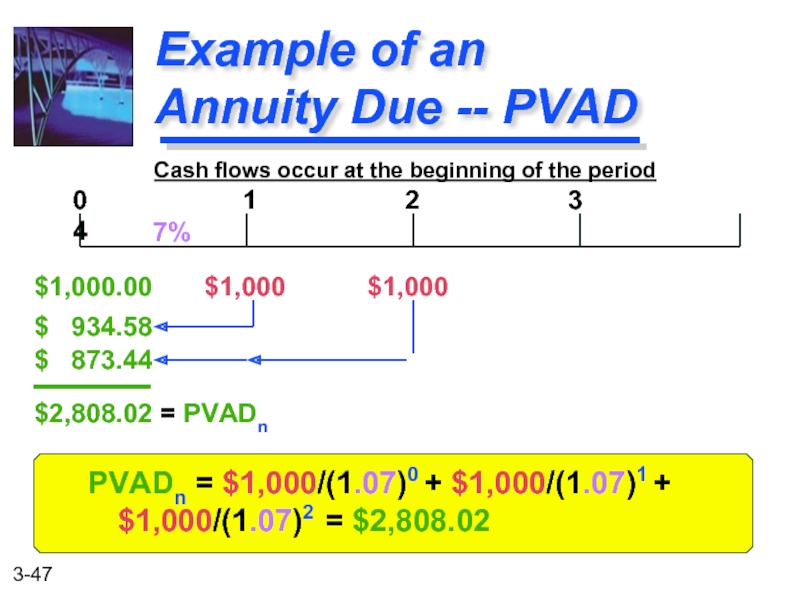
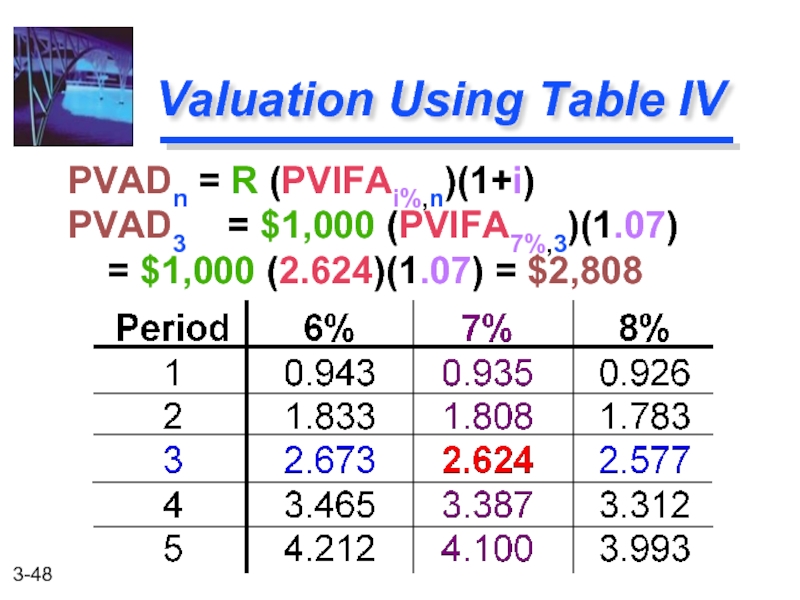

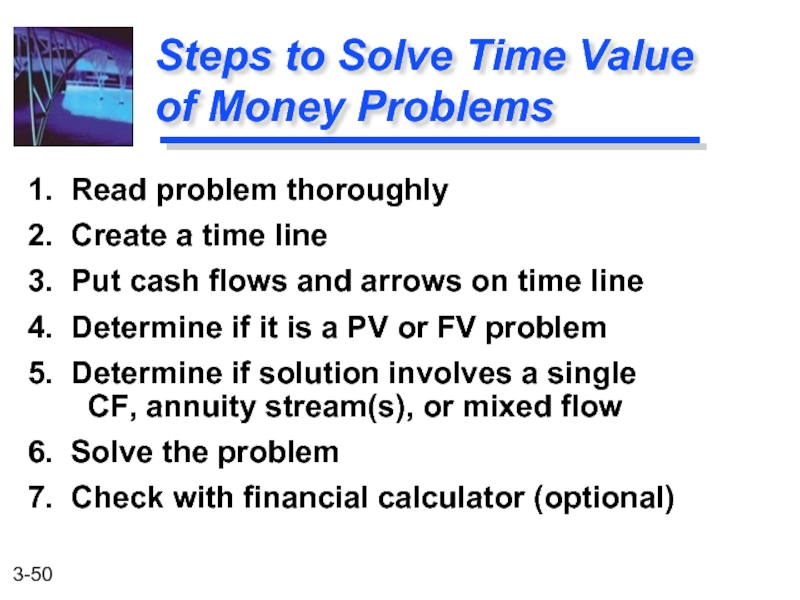
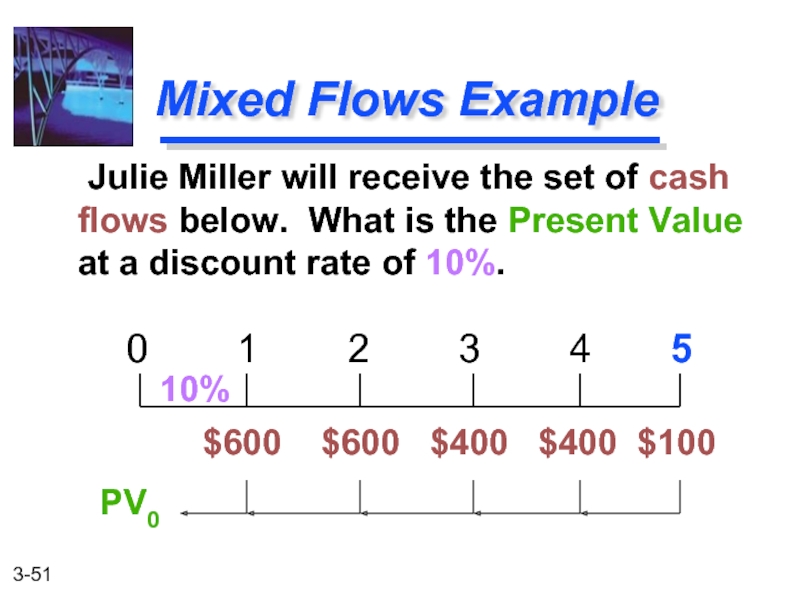
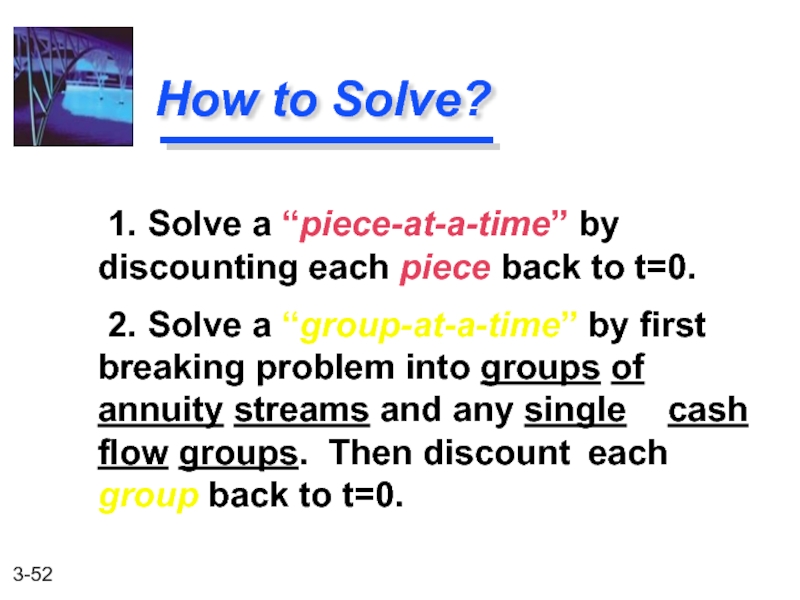
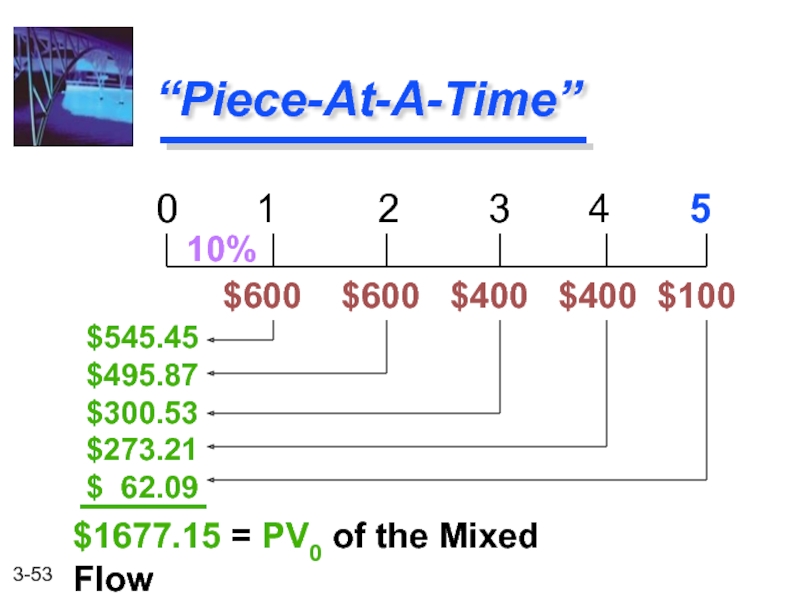
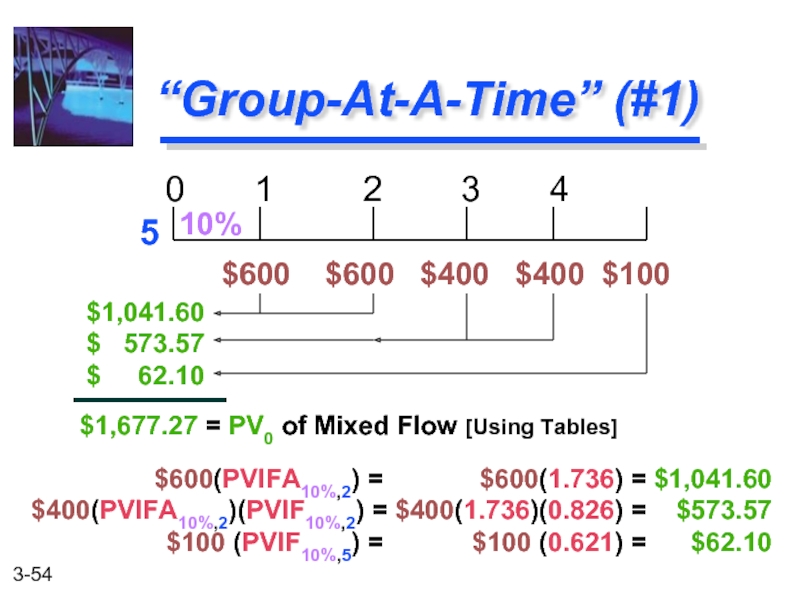
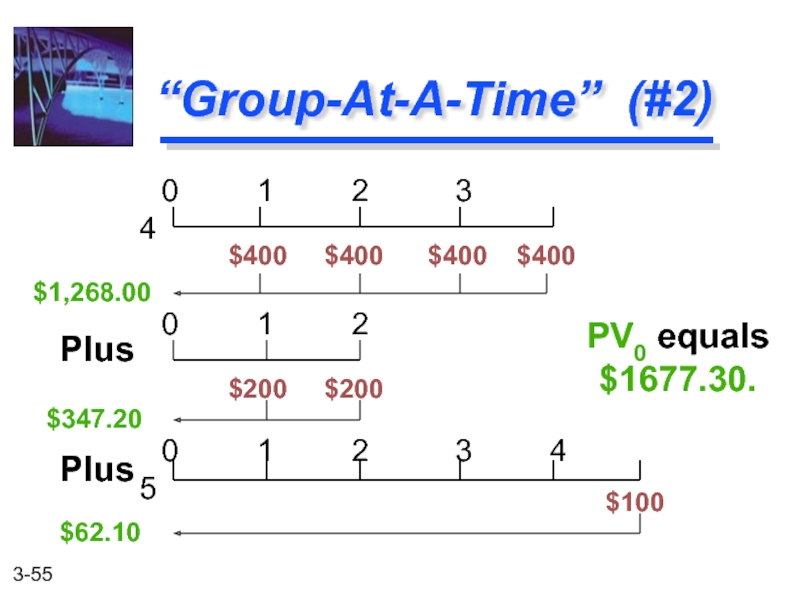
![General Formula:FVn = PV0(1 + [i/m])mn n: Number of Years m: Compounding Periods per Year i: Annual Interest Rate FVn,m:](/img/tmb/1/39864/b5fafc96c7ded673b4e2572b95c8d41d-800x.jpg)
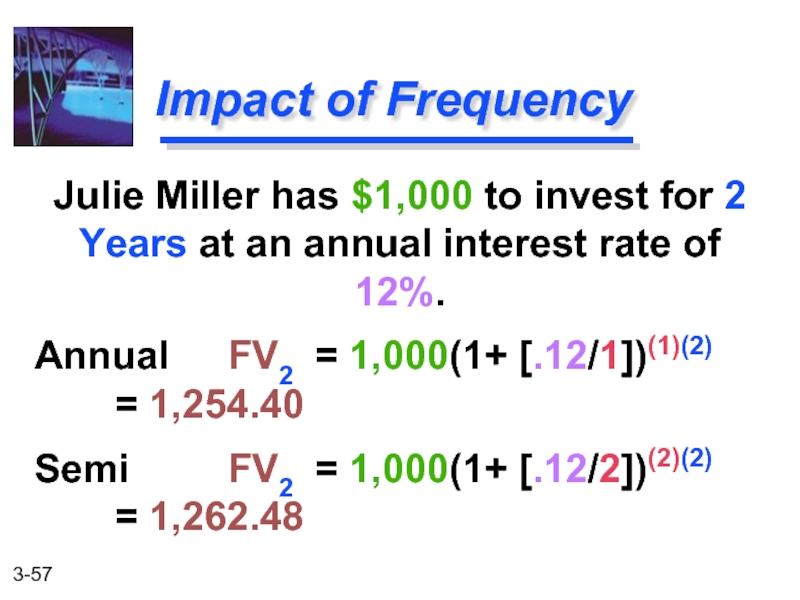
![Qrtly FV2 = 1,000(1+ [.12/4])(4)(2) = 1,266.77Monthly FV2 = 1,000(1+ [.12/12])(12)(2) = 1,269.73Daily](/img/tmb/1/39864/9aa01f4c6ab6edb0e8fe090d0105e575-800x.jpg)
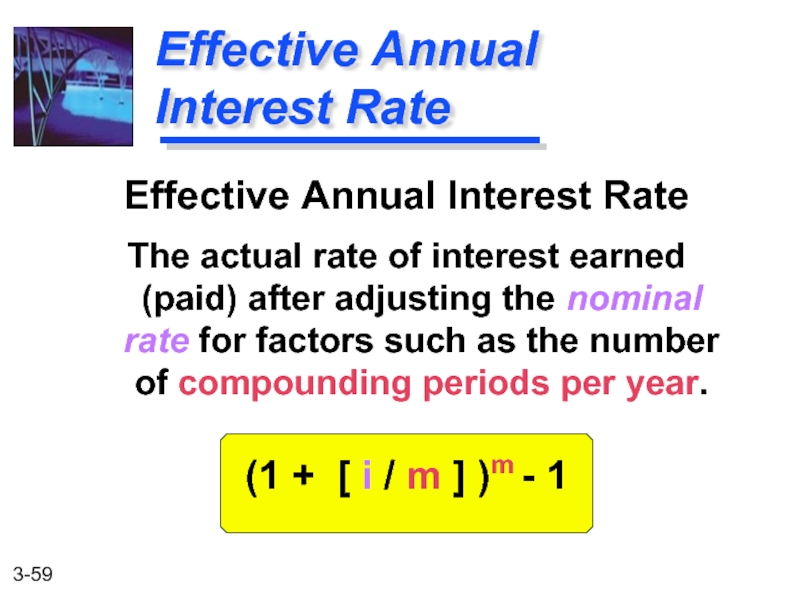
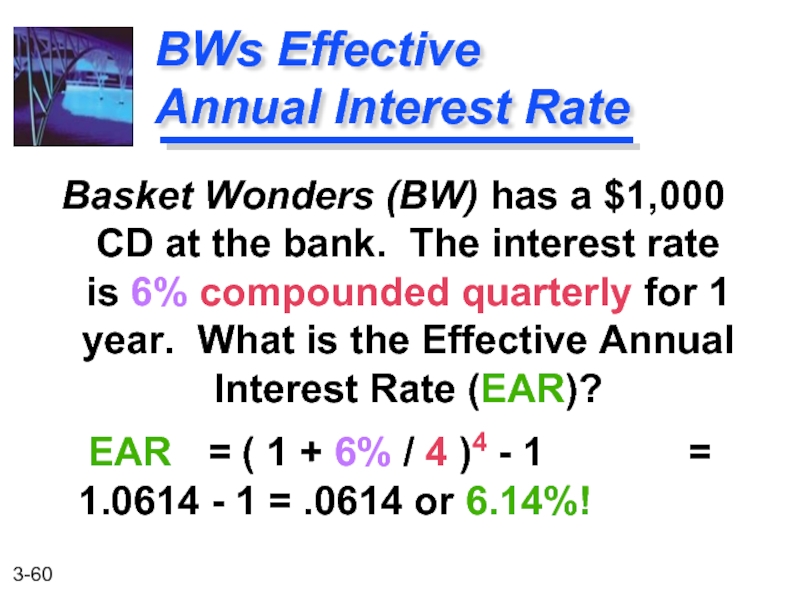
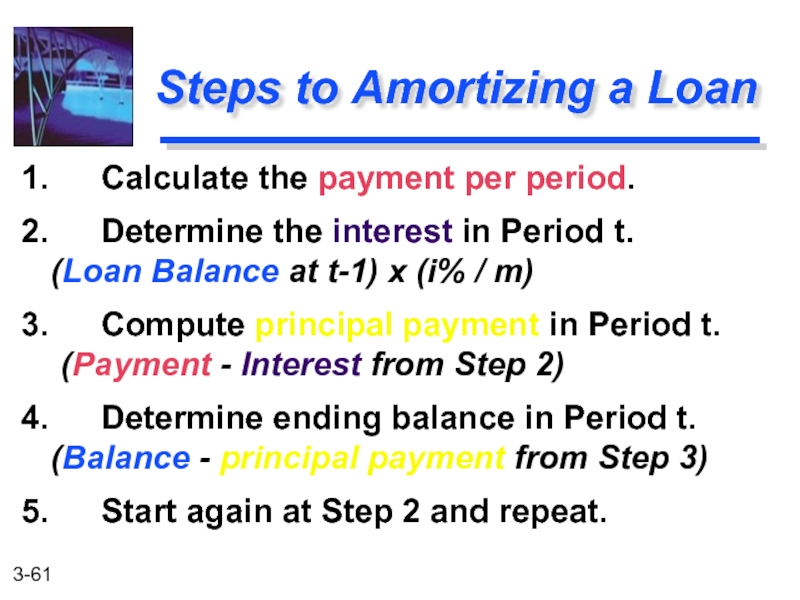
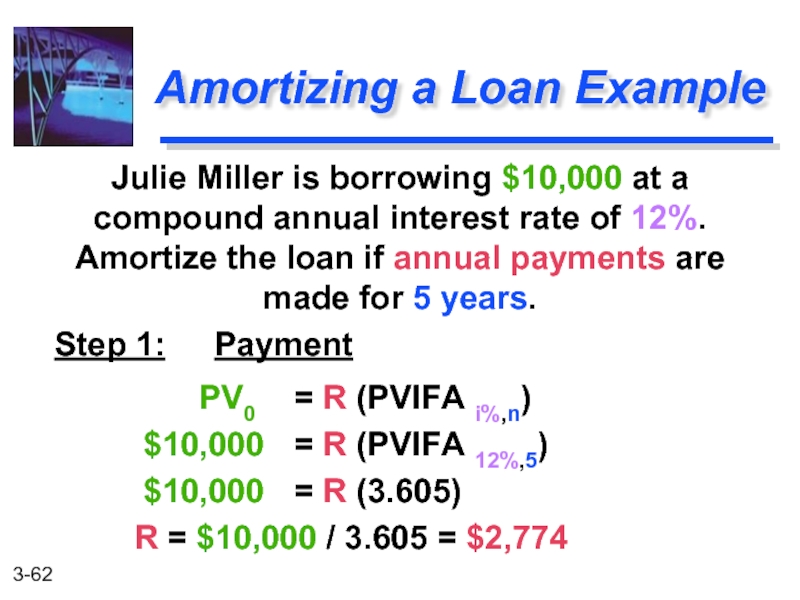
![Amortizing a Loan Example[Last Payment Slightly Higher Due to Rounding]](/img/tmb/1/39864/039418377dc15186df3d20e468d8f7b3-800x.jpg)
